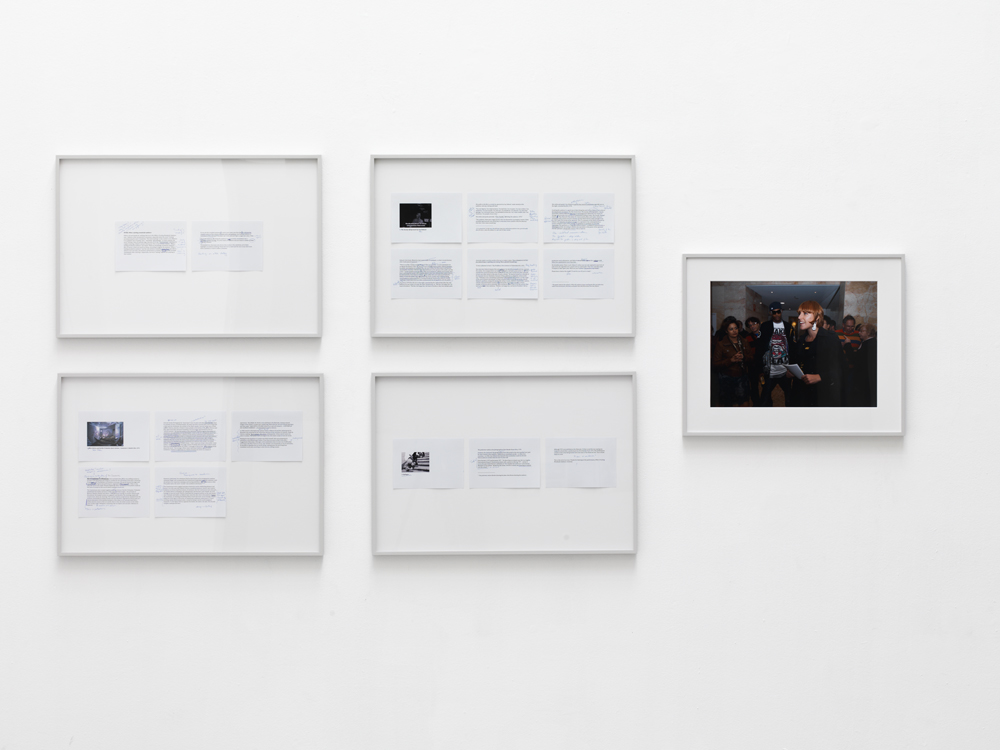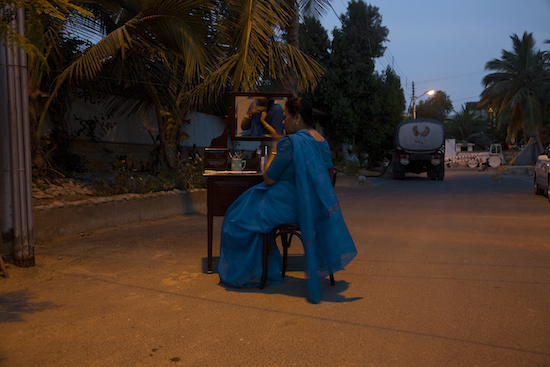Karachi Series 1 (Chandra Acarya, 7:50pm, 30 August 2008, Ramadan, Karachi)
2008 - Photography (Photography)
60H x 76W x 8D cm
Bani Abidi
The threshold in contemporary Pakistan between the security of private life and the increasingly violent and unpredictable public sphere is represented in Abidi’s 2009 series Karachi . These staged photographs were shot against the backdrop of the city’s empty streets at sundown during the holy month of Ramadan. During this time, Muslims fast and retreat indoors, leaving the city eerily empty. By portraying ordinary citizens from religious minorities, the photographs reclaim the occupation of public space. Domestic gestures are brought forward and presented in the streets. By being so specific about the times and locations where they were shot, Abidi tests the political potentials of these everyday gestures. In Karachi Series I (Chandra Acharya, 7:50pm, 30 August 2008, Ramadan, Karachi) (2009) a middle-aged woman sits in front of a dressing table plaiting her hair. The royal-blue sari suggests her identity as non-Muslim.
Bani Abidi’s practice deals heavily with political and cultural relations between India and Pakistan; she has a personal interest in this, as she lives and works in both New Delhi and Karachi. The artist’s subject matter ranges from border tensions to immigration conflicts, cultural diversity, and the relationship between private and public space. She works in the media of video, photography, and drawing.
Colors:
Related artist(s) to: Bani Abidi » Shilpa Gupta, » Adel Abdessemed, » Adrian Paci, » Dan Perjovschi, » Dora Garcia, » Eko Nugroho, » Hou Hanru, » Oliver Ressler, » Pedro Reyes, » San Francisco

© » KADIST
Dora Garcia
2012KLAU MICH is a TV and performance project by Dora García with Ellen Blumenstein, Samir Kandil, Jan Mech, TheaterChaosium, and Offener Kanal Kassel, during the 100 days of dOCUMENTA (13)....

© » KADIST
Eko Nugroho
2009Nugroho’s installations and performances have their roots in the shadow puppet rituals in Indonesia, particularly the Javanese Wayang tradition whose essence is in the representation of the shadows...

© » KADIST
Dora Garcia
2008Dora Garcia’s work is a result of institutional critique and more generally that of language, following the conceptual artists of the 1960s like Weiner and Kosuth and Fraser from the 1980s and 1990s...

© » KADIST
Shilpa Gupta
2009In Untitled (Sword) , addressing histories of colonialism with abstraction, a large steel blade extends from the gallery wall...

© » KADIST
Shilpa Gupta
2014These hand drawn maps are part of an ongoing series begun in 2008 in which Gupta asks ordinary people to sketch outlines of their home countries by memory...

© » KADIST
Shilpa Gupta
2014These hand drawn maps are part of an ongoing series begun in 2008 in which Gupta asks ordinary people to sketch outlines of their home countries by memory...

© » KADIST
Pedro Reyes
2012Pedro Reyes’s Los Mutantes ( Mutants , 2012) is composed of 170 plates that combine characters from ancient and modern mythologies...

© » KADIST
Shilpa Gupta
2008The three monkeys in Don’t See, Don’t Hear, Don’t Speak are a recurring motif in Gupta’s work and refer to the Japanese pictorial maxim of the “three wise monkeys” in which Mizaru covers his eyes to “see no evil,” Kikazaru covers his ears to “hear no evil,” and Iwazaru covers his mouth to “speak no evil.” For the various performative and photographic works that continue this investigation and critique of the political environment, Gupta stages children and adults holding their own or each other’s eyes, mouths and ears...

© » KADIST
Pedro Reyes
2005In Reyes’s words, “We should be able to extract the technological nutrients before we excrete our waste...



